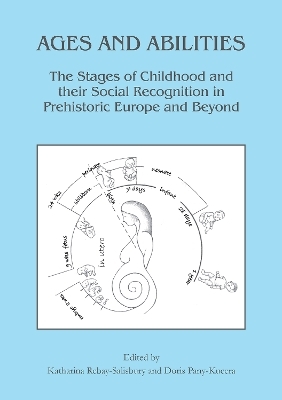
Ages and Abilities: The Stages of Childhood and their Social Recognition in Prehistoric Europe and Beyond
Archaeopress (Verlag)
978-1-78969-768-1 (ISBN)
Ages and Abilities explores social responses to childhood stages from the late Neolithic to Classical Antiquity in Central Europe and the Mediterranean and includes cross-cultural comparison to expand the theoretical and methodological framework. By comparing osteological and archaeological evidence, as well as integrating images and texts, authors consider whether childhood age classes are archaeologically recognizable, at which approximated ages transitions took place, whether they are gradual or abrupt and different for girls and boys. Age transitions may be marked by celebrations and rituals; cultural accentuation of developmental stages may be reflected by inclusion or exclusion at cemeteries, by objects associated with childhood such as feeding vessels and toys, and gradual access to adult material culture. Access to tools, weapons and status symbols, as well as children’s agency, rank and social status, are recurrent themes. The volume accounts for the variability in how a range of chronologically and geographically diverse communities perceived children and childhood, and at the same time, discloses universal trends in child development in the (pre-)historic past.
Katharina Rebay-Salisbury is an archaeologist with a research focus on the European Bronze and Iron Ages. She directs the research group ‘Prehistoric Identities’ at the Institute for Oriental and European Archaeology of the Austrian Academy of Sciences and teaches at the University of Vienna. ; Doris Pany-Kucera studied biological anthropology at the University of Vienna, focusing on muscle marks and joint changes on skeletal remains to reconstruct occupational stress and labour patterns (PhD 2015). She teaches at the Universities of Vienna and Pilsen.
Chapter 1: Introduction. Children’s developmental stages from biological, anthropological and archaeological perspectives – Katharina Rebay-Salisbury and Doris Pany-Kucera ;
Chapter 2: Weaponry and children: technological and social trajectories – Kathryn A. Kamp and John C. Whittaker ;
Chapter 3: How and when life is considered to have begun in past societies: child burials at the cemetery of Durankulak, north-east Bulgaria - Ekaterina Alexandrova Stamboliyska-Petrova ;
Chapter 4: Inherited rank and own abilities: children in Corded Ware and Bell Beaker communities of the Traisen Valley, Lower Austria – Daniela Kern ;
Chapter 5: The little ones in the Early Bronze Age: foetuses, newborns and infants in the Únětice Culture in Bohemia, Moravia and Slovakia – Lucie Vélová, Katarína Hladíková and Klaudia Daňová ;
Chapter 6: Ages and life stages at the Middle Bronze Age cemetery of Pitten, Lower Austria – Katharina Rebay-Salisbury, with contributions by Patrik Galeta, Walther Parson, Doris Pany-Kucera, Michaela Spannagl-Steiner and Christina Strobl ;
Chapter 7: Children in the territory of Western Hungary during the Early and Middle Bronze Age: the recognition of developmental stages in the past – Eszter Melis, Tamás Hajdu, Kitti Köhler and Viktória Kiss ;
Chapter 8: Childhood in the Late Bronze and Early Iron Age in the southern Carpathian Basin – Daria Ložnjak Dizdar and Petra Rajić Šikanjić ;
Chapter 9: Mycenaean childhood: Linear B script set against archaeological artefacts – Beata Kaczmarek ;
Chapter 10: Dumu.gaba, ṣiḫru e Guruš/sal.Tur.tur – Nadia Pezzulla ;
Chapter 11: Identifying social and cultural thresholds in sub-adult burials – Francesca Fulminante ;
Chapter 12: Child personhood in Iron Age Veneto: insights from micro-scale contextual analysis and burial taphonomy – Elisa Perego, Veronica Tamorri and Rafael Scopacasa ;
Chapter 13: The recognition of children and child-specific burial practices at the necropolis of Spina, Italy – Anna Serra ;
Chapter 14: Greek children and their wheel carts on Attic Vases – Hanna Ammar ;
Chapter 15: Teeny-tiny little coffins: from the embrace of the mother to the embrace of Hades in ancient Greek society – Alexandra Syrogianni ;
Chapter 16: Pueri nascentes: rituals, birth and social recognition in Ancient Rome – Irene Mañas Romero and José Nicolás Saiz López
| Erscheinungsdatum | 09.11.2020 |
|---|---|
| Reihe/Serie | Childhood in the Past Monograph Series |
| Verlagsort | Oxford |
| Sprache | englisch |
| Maße | 176 x 250 mm |
| Gewicht | 710 g |
| Themenwelt | Sachbuch/Ratgeber ► Gesundheit / Leben / Psychologie ► Schwangerschaft / Geburt |
| Geisteswissenschaften ► Archäologie | |
| Geschichte ► Allgemeine Geschichte ► Vor- und Frühgeschichte | |
| Geisteswissenschaften ► Geschichte ► Regional- / Ländergeschichte | |
| Sozialwissenschaften ► Soziologie ► Mikrosoziologie | |
| ISBN-10 | 1-78969-768-9 / 1789697689 |
| ISBN-13 | 978-1-78969-768-1 / 9781789697681 |
| Zustand | Neuware |
| Haben Sie eine Frage zum Produkt? |
aus dem Bereich


